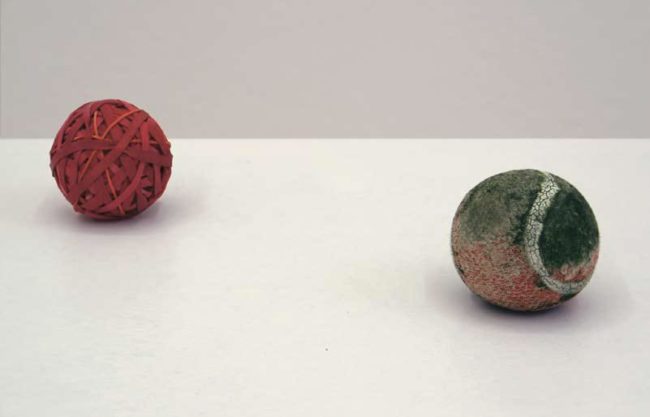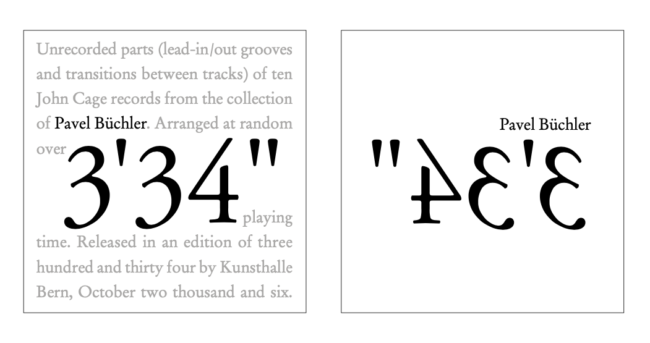One of the most common tricks of any stand-up comedian, as well as a commonplace advice for a best man in search of a good lead-in to his fraternal (and often cruel) address to the groom, is to talk about a missing speech that had been thoroughly prepared but will be referred to rather than delivered—‘I had written a speech about...’. In this way, you can expand as much as you want into something you say you are not saying. What follows is generally the tale of an event that happened ‘just this morning,’ or ‘on my way here’, which made the prepared speech seem bland and innocuous in comparison.
I will apply this technique here, but not before forking my path
a few more times.
Writing about Pavel Büchler’s work gives me all the licence I need. I am brothered to him in the desire to play. Our games have similarities, they are always about chance encounters. Chance encounters, I should say, that always take place at the foot of the castle.1 I realise that I can play my game and, by doing so, I can speak about his work without speaking about it because the operation that I may engage in is always doing its critical job already in being similar to his. I can represent him in the way that someone stands in for a missing person. I can make an image of the way he makes an image. I want him to remain unaccountable in my text. I want him to resist my categories, my assumptions, to live in the free wheeling analogy I set forth, to stay unfixed.
Pavel is like a quantum physicist of the art historical reference. He splits the atom on and on, onto its smallest expression, looking for a reaction. The reaction, the combustion, needs to say it all in saying nothing, and vice versa, otherwise nothing actually sets itself off. These detonators may fail. That pigmy tennis ball that shrunk and shriveled over a thousand years in Pavel’s garden, under inclement Manchester weather (‘That corpse you planted last year in your garden, has it begun to sprout? Will it bloom this year?’2) and which I noticed a year ago sitting on the fence like Kafka’s Odradek, is a perfect example. Nothing is too much, too little, too soon or too late in that tennis ball. What is said is said without a yes or a no... it would rather not bounce, it has grown old, it is out of breath, that’s it; it’s a curve ball of time, a gray, queer, twisted misfit, a degenerate, uncomposed, decomposed dirty old man of a ball, abject and deviant. I think it was Valéry who said ‘entre deux mots le moindre’ (between two words choose the least complicated). This fits. Pavel is gnawing at the bone of conceptual art, if there’s still some meat, he will notice it; the bone can always be further undressed. When silence has been named there’s still the space between two silences to be found, and it can be hunted down, pulled over on the interstate. It’s all about the serious pursuit of the ultimate frontier of nothing. I woke up thinking that if Cage said, ‘I have nothing to say and I am saying it,’ Pavel wants to say, ‘I have nothing to say and I am not even saying that.’ It’s a kind of reckless trans art historical machismo of who can flex the minimal register further.
Warhol’s Empire State is also online again in Pavel’s hard drive; nine frames, touched by the JPEG patina that grows on every image in the present, like mold. The aura of the ghost of the shadow brought back to life, recruited for a new dip in a murky black and white pool of art historical footnotes. How to make an image of the very ‘fact’ of the image, the one that has got installed like an operating system in the mind of the culture? Reanimate the remainder, weave the shred onto itself again. It’s an intimate dialogue, a whisper, the real image is not in the image of the building but in the mysterious force that placed it there. A take of/on the Empire State is always also an image of Andy Warhol, an image of the culture that consumed him, devoured him, in the exact same way that he had prescribed; as in the Kassel internet exchange that led to a consensual, scripted cannibalism; menu and all.
Here’s the first part of my speech then; the one I claim I had written for the ceremony. For months I have been keeping every bit of news that has the word ‘moon’ in it. It sounds like a mammoth enterprise but nowadays it only takes one click to set up a ‘google alert’. So, I had prepared a poem on the moon using a phrase from each piece of news containing the word. Then I saw that Pavel had made a video where he froze Apollo 11 at lift-off, like a match that skids forever in the moment of lighting-up, where the fire is never finally consumed. Apollo is like an unconsumated marriage: the moon is never reached, the landing is not accomplished. It is a constant promise that burns before it has a chance to burn. The moon poem would have worked beautifully. It was as Cagean as Cagean goes, it was in touch with the moon diegesis of Pavel’s video and in touch with the extra-diegetic streak of the exhibition—the repeated operation of construing the lyrical from a technical matrix, something akin to his unicode Rose which is a rose, and is a rose and is a rose although it isn’t, it’s just an email attachment that didn’t give in to the obvious. I will refrain, then, from including an extract from my poem on the moon. I will just mention that in using google alerts I came across the news that NASA, just a month ago, lost the original tapes of the moon landing. The lost tapes are of a crisp, clear video that has never been seen by the public. The footage that is totally available for inspection, the one that was transmitted to the world in ’69, originates in a video camera directly recording the screen of a monitor. That is why it is so grainy, blurry and contrasted. The image transmitted from the moon supposedly had too many scan lines and there was no technical capacity to retransmit them, other than through this artisan contraption. As with The Odyssey we now have only the secondary text of a troubadour that forgets some of the (scan) lines, someone who heard it from someone who heard it from Homer.
To touch on Kafka again, the aforementioned is similar to the
words echoing from the castle that reach us through the low-fi
anachronistic sound contraption that creeps into every room of
Kunsthalle Bern like a parasitic, post-apocallyptic crawling plant; a sound system that, in its turn, delivers an incomprehensible message from above in a digitally manufactured German accent
technical tour de force, I am told). Being at the foot of the castle
is what it’s all about; it’s what fashioned Pavel Büchler to begin with—a young man looking at the images of contraband catalogues coming from the top of the hill, from Kunsthalle Bern, indeed. A culturally autistic subject dreaming the mystery of the black and white photographs of When Attitudes Become Form, consuming
them like images (not like registers), consuming them like myths,
emulating their strange incomprehensible beauty, passing by the
text, passing by the concept, sitting in the Café Slavia, in the Prague
of the ’70s for hours with those signs of untold possibility: ‘this
can be done, art can look like this.’ And then, candidly, being
driven deeper into the substance of the operation, falling in love,
becoming forever af-filia-ted to conceptual art as his chronic deaf
interlocutor.
All of the above was scratched. So finally, this is what happened ‘on my way here’. Against all odds, in a stubborn insistence, I set myself to go to an Alain Badiou talk in New York. I really had no time and I knew it. Even though I would be forty minutes late to the seminar room, I still persisted. I repeated many times that I wanted ‘to see his face’. And, for a conceptual reason, it seems I did. I made it there in time to hear the questions directed at Badiou at the end of the talk. Three days later I was with Tanya and Joseph, our five-month-old baby, by a pure chance, in a typical Manhattan non-place—32nd and Park—trying to take a family portrait of the three of us. It wasn’t working out, so I turned around and asked the first person that was walking up the street to please help us take the photo. It was an aging man walking slowly with a map of the city in his hand. As he held the camera in front of us, I looked at him and exclaimed, ‘Mais vous etes Alain Badiou!’ He shook his head in disbelief; how could someone recognise a French philosopher, whose image is published in such a restricted circuit, in midtown Manhattan of all places? I joked, ‘Qu’ es-ce que vous voulez, vous etes une célébrité!’ He took the photograph. Then I begged forgiveness for being a fetishist and asked him to sign a paper stating that he had taken the image. He did, but not before returning the joke, ‘Not all fetishism is bad.’
I am proud not to have fallen prey to the reflex to take a photo
of Badiou alongside us, to have this flash image of a red-eyed,
hunted down celebrity philosopher in the neon wilderness. We
were witness to an extraordinary encounter but we have nothing
to show for it, and so it follows that the event doesn’t succumb
to its image, although it is nevertheless sanctioned by a signature.
Like Pavel’s unicode Rose which refuses to give in to the figure
that corresponds to it, I don’t have the accountable Badiou that I
can trade like a baseball card. I have his image as an event, resisting
forever its fixation, the unending gift of a chance encounter.
For Pavel Buchler's exhibition at Kunsthalle Bern.


